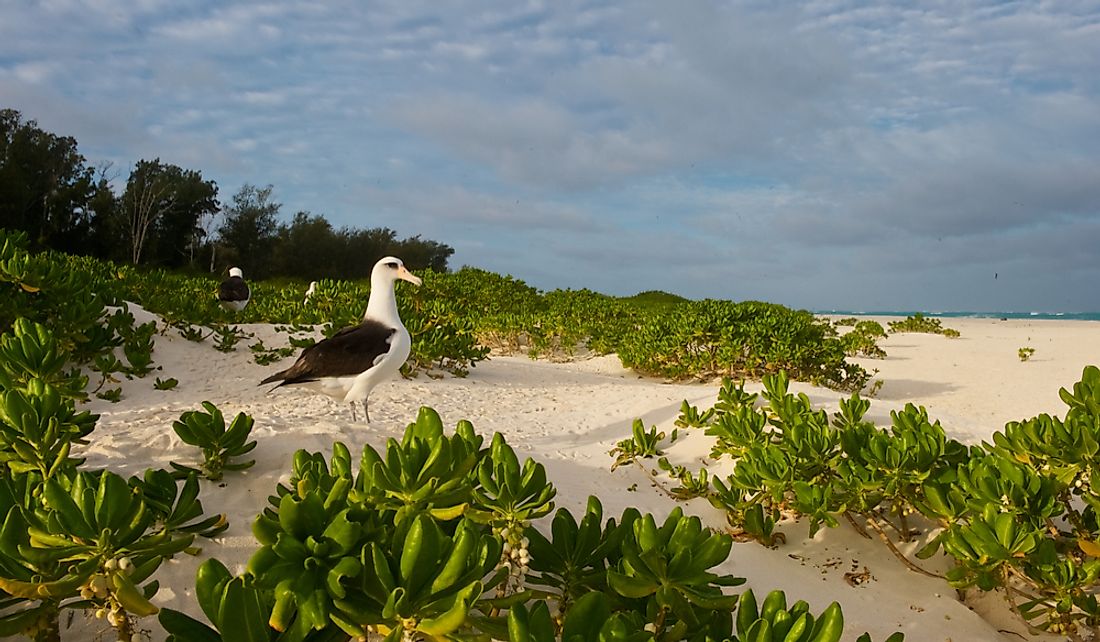Where Is Midway Atoll?

Midway Atoll is a 2.4 square mile atoll, which is a ring-shaped coral reef, located in the North Pacific Ocean. The unorganized, unincorporated US territory is the only atoll or island in the Hawaiian archipelago that is not part of the state of Hawaii. Midway Atoll observes the Samoa Time Zone, which is 11 hours behind Coordinated Universal Time, and 1 hour behind the time zone observed in Hawaii. The atoll is inhabited by approximately 60 individuals, which include employees of the U.S. Fish and Wildlife Service and a small number of contract workers. Midway Atoll has been closed to public visitation since 2012 due to budget cutbacks, but had 332 visitors during its final year.
Location
Midway Atoll is located in the North Pacific Ocean, roughly halfway between Asia and North America. The atoll is not considered part of the state of Hawaii as a result of the Hawaii Organic Act, which officially annexed Hawaii to the United States. The Hawaii Admissions Act, which identified all islands that Hawaii would inherit, excluded Midway Atoll, as well as Kingman Reef, Johnston Reef, and Palmyra Island.
Midway Atoll is approximately 2,200 nautical miles east of Tokyo, 2,800 nautical miles west of San Francisco, and is situated in the northwestern part of the Hawaiian Islands.
Geography
Midway Atoll is part of the Hawaiian-Emperor seamount chain, an undersea mountain range that includes volcanic islands, seamounts, and atolls, and stretches from the Aleutian Islands to Hawaii. Midway Atoll consists of a ring-shaped coral reef and numerous sand isles. The two largest islands in the atoll, Sand Island and Eastern Island, are inhabited by numerous seabird species.
Midway Atoll was created about 28 million years ago after lava flowing from a hotspot in the Earth’s crust created a volcanic island. Additionally, the islands were formed by shifting coral-sands inside the reef.
History
The atoll was discovered on July 5, 1859, by Captain N.C. Middlebrooks, of the sealing ship Gambia, who named it Middlebrook Island. Middlebrook claimed the atoll for the United States as part of the Guano Islands Act (1856), which allowed Americans to obtain guano from all uninhabited islands. Years later, Captain William Reynolds took formal possession of the atoll for the US on August 28, 1867, and its name was changed to Midway Atoll.
Flora and Fauna
The atoll is an important habitat in the region that serves as a breeding ground for about 17 seabird species. Numerous native seabird species live on Midway Atoll, including 39% of the black-footed albatross population, 70% of the Laysan albatross population, as well as a small number of short-tailed albatross. The U.S. Fish and Wildlife Service also relocated 42 endangered Laysan ducks to the atoll in an attempt to conserve the species.
There are approximately 250 species of marine animals in the 300,000 acres of surrounding and lagoon waters. Numerous invasive exotic plant species, such as ironwood trees, were introduced to Midway Atoll to act as windbreakers. In fact, 75% of the 200 plant species on the atoll are non-native.











